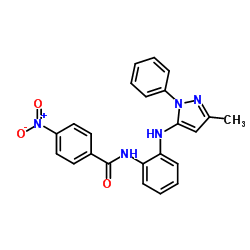1,3-Diethyl-2-thiobarbituricacid

1,3-Diethyl-2-thiobarbituricacid structure
|
Common Name | 1,3-Diethyl-2-thiobarbituricacid | ||
|---|---|---|---|---|
| CAS Number | 5217-47-0 | Molecular Weight | 413.429 | |
| Density | 1.3±0.1 g/cm3 | Boiling Point | 551.3±50.0 °C at 760 mmHg | |
| Molecular Formula | C23H19N5O3 | Melting Point | 109-112 °C(lit.) | |
| MSDS | Chinese USA | Flash Point | 287.2±30.1 °C | |
| Symbol |

GHS06 |
Signal Word | Danger | |
|
Defective CFTR expression and function are detectable in blood monocytes: development of a new blood test for cystic fibrosis.
PLoS ONE 6 , e22212, (2011) Evaluation of cystic fibrosis transmembrane conductance regulator (CFTR) functional activity to assess new therapies and define diagnosis of cystic fibrosis (CF) is cumbersome. It is known that leukocytes express detectable levels of CFTR but the molecule has... |
|
|
Electroorganic synthesis of new benzofuro[2,3-d]pyrimidine derivatives.
J. Org. Chem. 67(14) , 5036-39, (2002) Electrochemical oxidation of 3,4-dihydroxybenzoic acid (1) in the presence of 1,3-dimethylbarbituric acid (2) and 1,3-diethyl-2-thiobarbituric acid (3) as nucleophiles in aqueous solution has been studied using cyclic voltammetry and controlled-potential coul... |
|
|
1,3-Diethyl-2-thiobarbituric acid as an alternative coinitiator for acidic photopolymerizable dental materials.
J. Biomed. Mater. Res. B. Appl. Biomater. 101(7) , 1217-21, (2013) The ethyl-4-dimethylaminobenzoate (EDAB) is widely used as a coinitiator of the camphorquinone (CQ), but in acidic circumstances it might present some instability, reducing the polymerization efficiency of the material. Considering this, new coinitiators are ... |
|
|
High-performance liquid chromatographic determination of nicotine and its urinary metabolites via their 1,3-diethyl-2-thiobarbituric acid derivatives.
J. Chromatogr. A. 613(1) , 95-103, (1993) The 1,3-diethyl-2-thiobarbituric acid (DETBA) assay for nicotine metabolites has been improved so that it can be used to determine the concentrations of nicotine and up to 12 metabolites in the urine of humans and laboratory animals, including phase 2 metabol... |
|
|
Urine test for the assessment of smoking status.
Br. J. Biomed. Sci. 58(2) , 61-5, (2001) A simple, quick and inexpensive test for smoking status would be useful in a variety of settings. The non-polar barbituric acid derivative 1,3-dibutyl-2-thiobarbituric acid (DBTB) is described as a novel derivatisation reagent for nicotine and its metabolites... |
|
|
Optimized determination of malondialdehyde in plasma lipid extracts using 1,3-diethyl-2-thiobarbituric acid: influence of detection method and relations with lipids and fatty acids in plasma from healthy adults.
Clin. Chim. Acta 208(1-2) , 63-76, (1992) We investigated the influence of different concentrations of Fe3+, phosphoric acid, butylated hydroxytoluene and glutathione on the production of the malondialdehyde-1,3-diethyl-2-thiobarbituric acid adduct in plasma lipid extracts. Following organic solvent ... |
|
|
A simple, inexpensive urine test of smoking.
IARC Sci. Publ. (74) , 183-93, (1986) Three novel colorimetric methods of detecting urinary nicotine metabolites called the barbituric acid, diethylthiobarbituric acid (DETB) and DETB-extraction methods were evaluated for use as a simple cheap objective test of smoking. Urine samples were collect... |
|
|
Assessment of simple colorimetric procedures to determine smoking status of diabetic subjects.
Clin. Chem. 44(2) , 275-80, (1998) The performance of a simple colorimetric assay for urinary nicotine metabolites to assess smoking status in diabetic subjects (n = 251) was investigated. Several variations of the colorimetric assay and a qualitative extraction procedure were evaluated in com... |
|
|
A simple, inexpensive urine test of smoking.
Thorax 40(5) , 351-7, (1985) Three novel colorimetric methods of detecting urinary nicotine metabolites called the barbituric acid, diethylthiobarbituric acid (DETB), and DETB extraction methods were evaluated for use as a simple, cheap, objective test of smoking. Urine samples were coll... |
|
|
Effect of selenium enrichment on antioxidant activities and chemical composition of Lentinula edodes (Berk.) Pegl. mycelial extracts.
Food Chem. Toxicol. 48(4) , 1085-91, (2010) Preparations derived from Lentinula edodes (Berk.) Pegl. mycelium are worldwide used as dietary supplements containing compounds active as immune system enhancers, demonstrating chemopreventive and anticancer activity. L. edodes mycelium enriched with organic... |